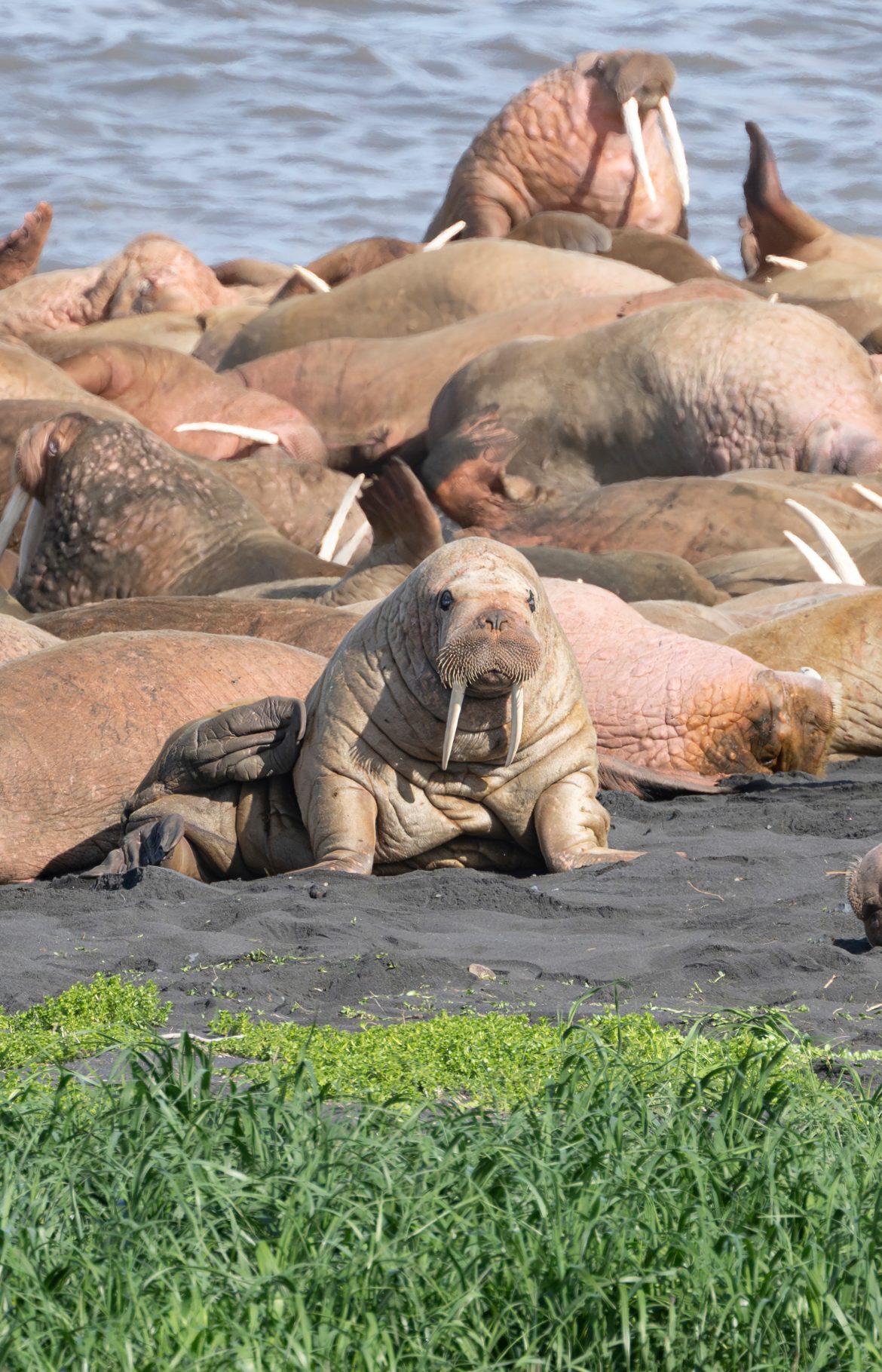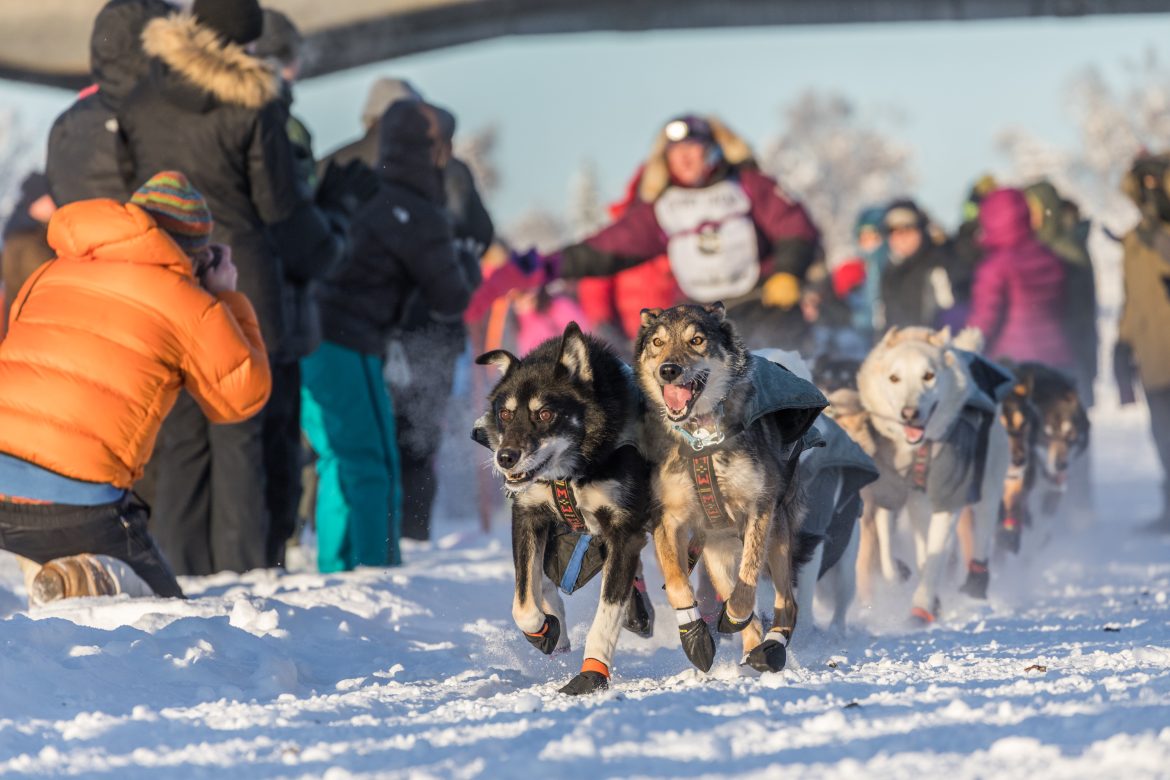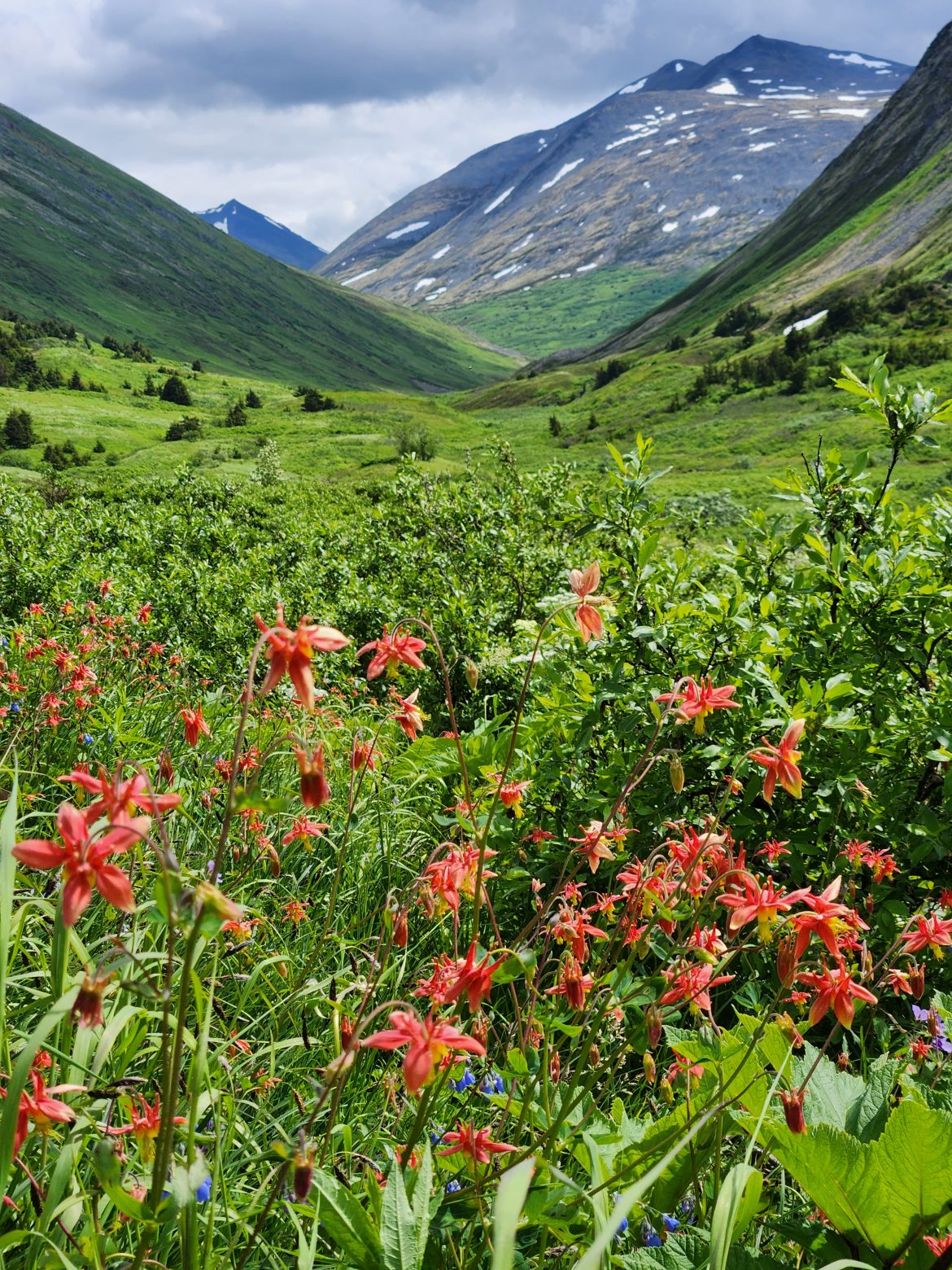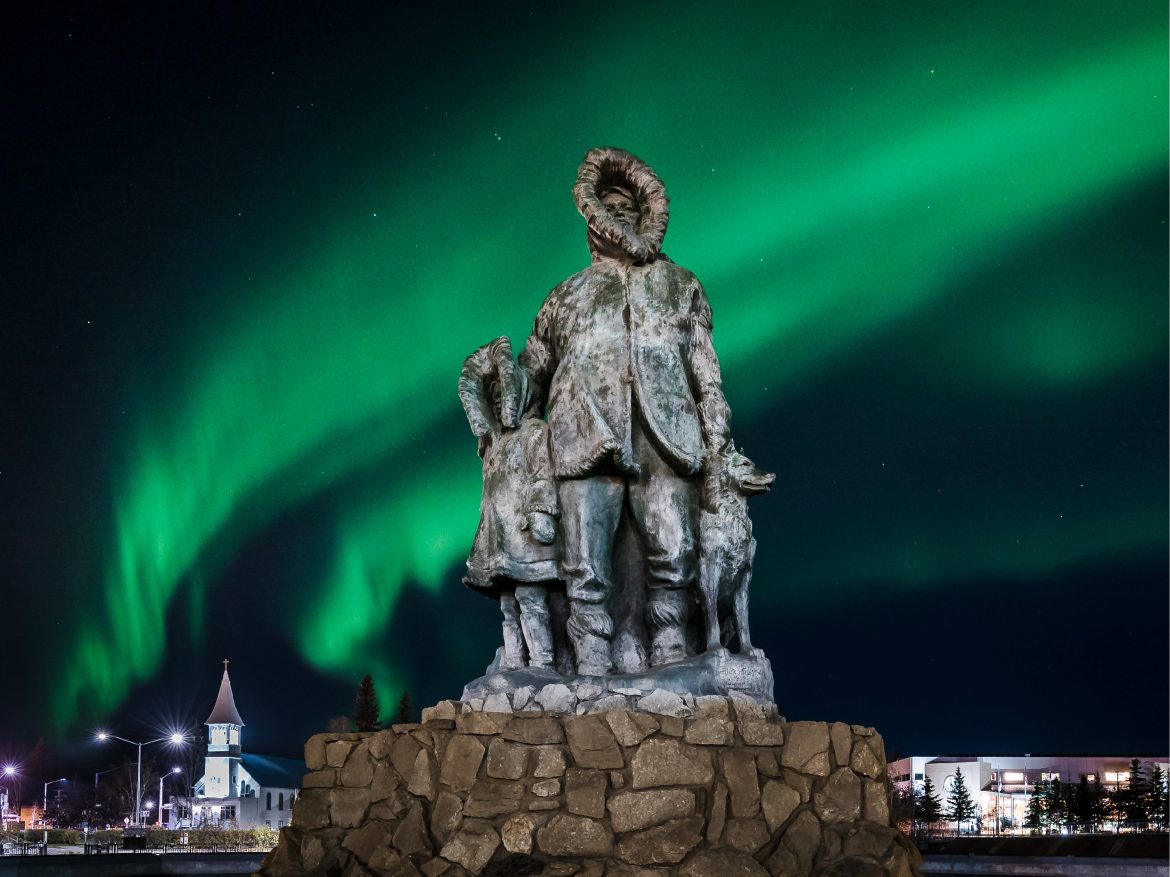DIGENEGH (MCGRATH) “Over on the Kuskokwim River” in Deg Xinag, the Athabascan language of Shageluk, Anvik, and the Athabascans at Holy Cross. Of about 275 Deg Hit’an people, approximately 40 speak the language. McGrath is featured in Luc Mehl’s story in this month’s Community section. (source: Deg Xinag Learners’ Dictionary) SUYITNA (SUSITNA RIVER) Dena’ina for “sandy river,” referring to the river’s silt and many sandbars. The river begins at the Susitna Glacier in the Alaska Range and runs 313 miles to the ocean near Anchorage. It drains nearly 20,000 square miles, mostly within the Matanuska-Susitna Borough, home to this year’s Arctic Winter Games. Learn more about the games in this month’s Profile section by Tim Lydon. (source: Shem Pete’s Alaska) Above: Sandbars in the Susitna River as seen from the Denali Highway. Courtesy Bo Mertz
Kyle Worl is an athlete and coach competing in the arctic sports category of this month’s Arctic Winter Games, being held in the Mat-Su valley. The arctic sports events, which originated over many generations in Indigenous communities across the circumpolar north, are a high- light of the games. They include the two-foot high kick, knuckle hop, and other sports linked to Indigenous hunting skills. The Arctic Winter Games also host com- petitions in hockey, skiing, skating, and other sports.
Sometimes you get lucky, and that winning photo practically takes itself. Other times you have to work for it, angling for the best composition or waiting for perfect lighting. Either way, photographers create art that captures the viewer’s eye—and sometimes their heart, as is the casewith our grand prize winner. What we always look for when selecting finalists and then winning images from this contest is, first and foremost, an emotional reaction: Does the picture make us think Wow!? If so, then we look at technical merit such as whether the image is in focus, has a pleasing or surprising composition, or is overprocessed. Blurry, ho-hum, or fake coloring all get an automatic pass. While we appreciate those rare times when every aspect of a scene synchronizes and the photographer is paying attention enough to capture it on the fly, we know the thoughtfulness, time, and attention to detailit requires…
The Iditarod is Alaska’s most famous sled dog race, but it’s not the only one. Here are some other races happening this winter. Yukon Quest The Yukon Quest, begins February 3. Formerly, a 1,000-mile odyssey between Fairbanks and Whitehorse, Yukon, this year’s three races range from 100 to 450 miles, all within Canada. Fur Rendezvous Open World Championship Fur Rendezvous Open World Championship, Anchorage, February 23-March 3. Part of the “Fur Rondy” winter carnival, the races traverse Anchorage streets, forests,and parks. Annamaet Limited North American Championships Annamaet Limited North American Championships, Fairbanks, March 8-10.Features 4-, 6-, and 8-dog teams and 2-dog skijoring. Open North American Championship Open North American Championship, Fairbanks, March 15-17. This is the world’s oldest continuously held sled dog race. Communities and nonprofits host many other races between January and March, and of course mushing is about more than just racing.
March events bring sports and culture After 10 years abroad, the Arctic Winter Games return to Alaska this March 10-16. And for the first time, they will be held in the Matanuska-Susitna Borough north of Anchorage. “This is an amazing opportunity,” says Karen Lane, general manager of the 2024 Arctic Winter Games Host Society. “Alaskans can watch athletes competing from across the circumpolar north and experience cultural activities not often seen here.” Since 1968, the games have offered young athletes from northern and arctic nations a chance to compete on a global stage. Held every two years, they feature dozens of competitions, including skiing, hockey, and demanding Indigenous sports like the two-foot-high kick, kneel jump, and knuckle hop. An expected 2,000 athletes will compete this year from Alaska, Greenland, Scandinavia, Canada, and elsewhere. February is crunch-time for the host society, which for over a year has been planning a blizzard…
Alaska Native place names in this issue Iilgayaq (Bristol Bay) Possibly refers to a place to hide. Some Yup’ik language speakers say the name describes all of Bristol Bay, while others say it only refers to the Nushagak area of the bay. See the “Sense of Place” section for more on this special place. (source: Bristol Bay Native Corporation online place names mapping tool) Utqiagvik On December 1, 2016, residents of Barrow, mentioned in the “History” section, narrowly voted to change the city’s name to Utqiagvik, an Inupiat name meaning “place to gather wild roots.” (source: Inupiat Heritage Center) Taan (Prince of Wales Island) The Tlingit word for sea lion and the setting for the “Community” article. (source: Our Grandparents Names on the Land, edited by Thomas Thornton)
Good riddance to the days of film Very few people are nostalgic for the old days of photo processing: the interminable wait to see if you got even one decent image on a roll of 36 frames of film, the abject disappointment if you failed to, and the cost of prints and slides. If you had your own darkroom or worked in one, the routine included agitating film canisters by hand, mixing smelly chemicals, wielding tongs and washing trays, and the constant fear of light leaks. Wild horses couldn’t drag me back to those times, but I did have some interesting photo lab jobs over the years. My first was in a small Wasilla-based business. During that time, I also volunteered at a horse boarding stable and had lightly frostbitten my fingertips while wearing damp gloves. I quickly learned that peeling fingertips from winter’s nip does not go well with…
More than you see, fewer than you think peered around a boulder and there they were: a half dozen Dall rams bedded down, the nearest so close I could see my reflection in an amber eye framed by a curl of horn. They turned their heads to regard me but didn’t rise; instead, they gave what seemed to be a collective shrug as I settled in and raised my camera. I spent the next hours among them in the late August sun as they napped and grazed along the edge of that rock-strewn ridge, the air so still I could hear the echoing rush of the creek 2,000 feet below. That afternoon, still vivid after decades, explains as well as any why I came to Alaska: to meet wild animals in big, wild country. Pretty much everyone Alaska-bound hopes, even expects, the same. No doubt they’re out there, millions of…
A map and guide to best viewing sites The nonprofit Explore Fairbanks has published an Aurora Viewing Map & Guide to nine of the best spots in the area for viewing the northern lights. Places range from Creamer’s Field Migratory Waterfowl Refuge just a couple of miles from downtown to farther-out locations such as Denali National Park or the community of Coldfoot, which are several hours away by car. A few locations are within a 30-minute drive, and all are well known for their excellent aurora viewing. The guide includes some basic aurora science, pro tips for photographers, and a QR code for accessing real time aurora predictions. Its centerfold map is designed to help visitors easily find the best views. Fairbanks’ aurora season stretches from August 21 to April 21. Several companies offer guided tours to see and photograph the lights. The guide is available for free at the…
An excerpt from the novel Homestead by Melinda Moustakis Note: This edited excerpt from Chapter 1, “Pioneer Peak, June 1956” is taken from the novel Homestead, with permission of Flatiron Books, a division of Macmillan Publishers. Copyright ©2023 by Melinda Moustakis. God made the trees and men make the kindling, they say. One hundred and fifty acres of white spruce and paper birch, alder, aspen, cottonwood, and willow—spears of evergreen pointed at the sky, and the pale and peeling bark, and the leaves of every branch—all for the taking if the acres are proved. Fell the trees and clear twenty acres of land to seed a crop, raise a cabin with nails and timber, and weather the seasons. This is the way to earn and own the deed. Lawrence stands where the cabin will stand, the marsh and muskeg easing miles toward the marine inlet of Knik Arm, and beyond,…










